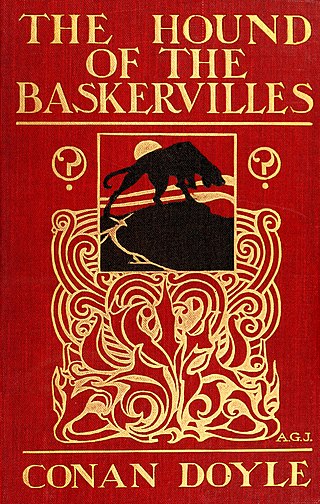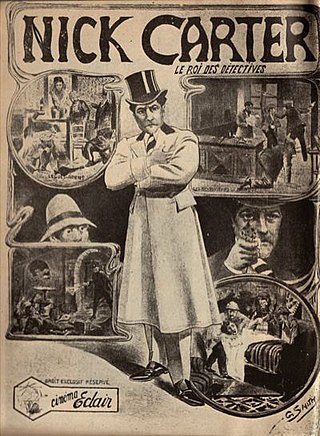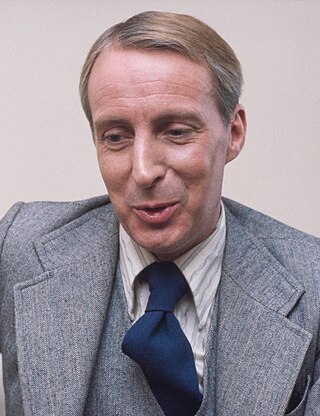Related Research Articles

The Hound of the Baskervilles is the third of the four crime novels by British writer Arthur Conan Doyle featuring the detective Sherlock Holmes. Originally serialised in The Strand Magazine from August 1901 to April 1902, it is set in 1889 largely on Dartmoor in Devon in England's West Country and tells the story of Holmes and Watson investigating the case of the legend of a fearsome, diabolical hound of supernatural origin. This was the first appearance of Holmes since his apparent death in "The Final Problem", and the success of The Hound of the Baskervilles led to the character's eventual revival.

Sir Christopher Frank Carandini Lee was an English actor and singer. In a long career which spanned over 60 years, Lee often portrayed villains, and appeared as Count Dracula in seven Hammer Horror films. His other film roles include Francisco Scaramanga in the James Bond film The Man with the Golden Gun (1974), Count Dooku in several Star Wars films (2002–2008), and Saruman in both the Lord of the Rings film trilogy (2001–2003) and the Hobbit film trilogy (2012–2014).

A Study in Scarlet is an 1887 detective novel by British writer Arthur Conan Doyle. The story marks the first appearance of Sherlock Holmes and Dr. Watson, who would become the most famous detective duo in literature. The book's title derives from a speech given by Holmes, a consulting detective, to his friend and chronicler Watson on the nature of his work, in which he describes the story's murder investigation as his "study in scarlet": "There's the scarlet thread of murder running through the colourless skein of life, and our duty is to unravel it, and isolate it, and expose every inch of it."

Mycroft Holmes is a fictional character appearing in stories written by Sir Arthur Conan Doyle from 1893 to 1908. The elder brother of detective Sherlock Holmes, he is a government official and a founding member of the Diogenes Club. Mycroft is described as having abilities of deduction and knowledge exceeding even those of his brother, though their practical use is limited by his dislike of fieldwork.

James William Fox is an English actor. He won a BAFTA Award for Most Promising Newcomer to Leading Film Roles for The Servant (1963). Other credits include The Miniver Story (1950), The Loneliness of the Long Distance Runner (1962), Those Magnificent Men in Their Flying Machines (1965), King Rat (1965), The Chase (1966), Thoroughly Modern Millie (1967), Isadora (1968), Performance (1970), before quitting acting for several years to be an evangelical Christian.

A mystery film is a genre of film that revolves around the solution of a problem or a crime. It focuses on the efforts of the detective, private investigator or amateur sleuth to solve the mysterious circumstances of an issue by means of clues, investigation, and clever deduction. By 2022, mystery films are generally referred to as detective fiction.
Amicus Productions was a British film production company, based at Shepperton Studios, England, active between 1962 and 1977. It was founded by American producers and screenwriters Milton Subotsky and Max Rosenberg.
John Richard Hopkins was an English film, stage, and television writer.

Ian William Richardson was a Scottish actor.

Terence Fisher was a British film director best known for his work for Hammer Films.
Christopher Robert Fowler was an English thriller writer. While working in the British film industry he became the author of fifty novels and short-story collections, including the Bryant & May mysteries, which record the adventures of two Golden Age detectives in modern-day London. His awards include the 2015 CWA Dagger in the Library, The Last Laugh Award (twice) and the British Fantasy Award, the Edge Hill Prize and the inaugural Green Carnation Award. His other works include screenplays, video games, graphic novels, audio and stage plays.

Murder Rooms: Mysteries of the Real Sherlock Holmes is a television crime drama series created by David Pirie, and co-produced by the BBC and WGBH Boston, a PBS station. Six episodes were made and were first broadcast on BBC Two, the first two on 4 and 5 January 2000, and the other four from 4 September to 2 October 2001.

Sherlock Holmes is the overall title given to the series of Sherlock Holmes adaptations produced by the British television company Granada Television between 1984 and 1994. The first two series were shown under the title The Adventures of Sherlock Holmes and were followed by subsequent series with the titles of other short story collections by Sir Arthur Conan Doyle.
Kurti & Doyle are a British scriptwriting team comprising Richard Kurti and Bev Doyle. They're best known for their work on fantasy television series such as BBC One's Robin Hood (2006), ITV1's Primeval (2007) and Sky 1's Sinbad (2012).
Peter Sasdy is a British film and television director.
The character of Count Dracula from the 1897 novel Dracula by Bram Stoker, has remained popular over the years, and many forms of media have adopted the character in various forms. In their book Dracula in Visual Media, authors John Edgar Browning and Caroline Joan S. Picart declared that no other horror character or vampire has been emulated more times than Count Dracula. Most variations of Dracula across film, comics, television and documentaries predominantly explore the character of Dracula as he was first portrayed in film, with only a few adapting Stoker's original narrative more closely. These including borrowing the look of Count Dracula in both the Universal's series of Dracula and Hammer's series of Dracula, including include the characters clothing, mannerisms, physical features hair style and his motivations such as wanting to be in a home away from Europe.
This article describes minor characters from the Sherlock Holmes stories by Sir Arthur Conan Doyle, and from non-canonical derived works. The list excludes the titular character as well as Dr. Watson, Professor Moriarty, Inspector Lestrade, Mycroft Holmes, Mrs. Hudson, Irene Adler, Colonel Moran, the Baker Street Irregulars, and characters not significant enough to mention.
Allan Cubitt was previously a teacher at John Ruskin High School, Croydon during the 1980s teaching English and Drama who became a British television, film, and theatre writer, director, and producer, best known for his work on Prime Suspect II and The Fall.

Sherlock Holmes and the Shadwell Shadows is a mystery novel by James Lovegrove. It is a Sherlock Holmes pastiche that involves H. P. Lovecraft's Cthulhu Mythos. It is the first book in the Cthulhu Casebooks trilogy. The second novel, Sherlock Holmes and the Miskatonic Monstrosities, was released in November 2017 and the third, Sherlock Holmes and the Sussex Sea-Devils, in November 2018.

British horror cinema is a sub-category of horror films made by British studios. Horror films began in Britain with silent films in the early 20th century. Some of the most successful British horror films were made by Hammer Film Productions around the 1960s. A distinguishing feature of British horror cinema from its foundations in the 1910s until the end of Hammer's prolific output in the genre in the 1970s was storylines based on, or referring to, the gothic literature of the 19th century.
References
- 1 2 3 "BFI Screenonline: Pirie, David (1953–) Biography". www.screenonline.org.uk. Retrieved 4 July 2022.
- 1 2 "BAFTA Awards". awards.bafta.org. Retrieved 1 July 2022.
- ↑ "Curtis Brown". www.curtisbrown.co.uk. Retrieved 4 July 2022.
- ↑ "One-hit wonders". TheGuardian.com . April 2008.
- ↑ "BFI Screenonline: Natural Lies (1992)". www.screenonline.org.uk. Retrieved 30 June 2022.
- ↑ "Black Easter". IMDb . 4 June 1995.
- ↑ Studemann, Frederick (14 November 2019). "Premonitions of Europe's migration crisis become reality". Financial Times.
- ↑ "Breaking the Waves". 29 May 2015.
- ↑ Biggane, Dan (17 June 2015). "Frome Festival: ell the Damn Story with screenwriters David Pirie and Stephen Volk". Somerset Guardian and Standard . Archived from the original on 21 July 2015. Retrieved 20 July 2015.
- ↑ The Woman in White (TV Mini Series 2018) - IMDb , retrieved 1 July 2022
- ↑ Fries, Laura (18 May 2000). "Review: 'Murder Rooms: The Dark Origins of Sherlock Holmes'". Variety . Retrieved 20 July 2015.
- ↑ "午夜大片免费版 - 网站地图". www.murder-rooms.com. Retrieved 17 June 2019.
- ↑ "Sad Cypress (2003)". BFI. Archived from the original on 2 December 2018. Retrieved 4 July 2022.
- ↑ "ITV1's 'Murderland' dents 'FlashForward'". Digital Spy . 20 October 2009.
- ↑ "TV ratings – Monday 19 October: Murderland draws more than 6m". TheGuardian.com . 20 October 2009.
- ↑ "Nightmare Movies by Kim Newman – Book Review". 26 April 2011.
- ↑ Pirie, David B. (15 January 2008). A New Heritage of Horror: The English Gothic Cinema. Bloomsbury Academic. ISBN 978-1845114824.
- ↑ Stasio, Marilyn (19 May 2002). "CRIME". The New York Times . Retrieved 20 July 2015.
- ↑ "THE PATIENT'S EYES: The Dark Beginnings of Sherlock Holmes". Publishers Weekly . Retrieved 20 July 2015.